DURANGO-SILVERTON (Day 17 - part 3)
Originally, the Utes used this area as their summer hunting grounds. For generations, they had roamed across eastern Utah, northern New Mexico and all of Colorado. The introduction of horses by the Spanish in early 1600's allowed them great mobility. Peaceful with both Spanish and American settlers, the Utes even served as allies against violent tribes such as the Apache. Yet as more and more settlers flowed in, treaties (starting in 1863) began to reduce the size of Ute land. In 1873, American officials met with Chief Ouray to create the Brunot Treaty, which gave up over four million acres of the San Juan Mountains, previously held as a Ute reservation.

Spurred on by the discovery of gold at Cherry Creek near Denver in 1858, prospectors first arrived in the Silverton area in 1860, defying government treaties and trespassing onto native lands. After the Brunot Treaty, there were no more restrictions. and people poured in by the thousands. Up to 1,500 claims were staked in 1873 alone. Mining companies placed ads in European newspapers, promising jobs and land. Many made the long ocean voyage, often crowded into the lower levels of dirty ships, and then had to travel halfway across the continent.
Officially founded in 1874, the town had a population of 100 within a year. In 1882, the railroad arrived, and the following year the population hit 3,000. But it was an extremely rough place to live... long severe winters with avalanche danger, high mining casualties (cave-ins, powder explosions), robberies, lynchings, not to mention the violence that came with saloons, gambling and prostitution. Suicide was not uncommon, especially among the prostitutes, and in 1918, a flu epidemic killed more than 150 people (about 10% of the population) within a three week period
The success of the mines continued to rise and fall over the decades, following the price of various metals. For example, war often increased the value of more regular metals, such such as zinc and copper, which could be used for infrastructure and military purposes. The last mine closed in 1991 and the town switched to tourism.
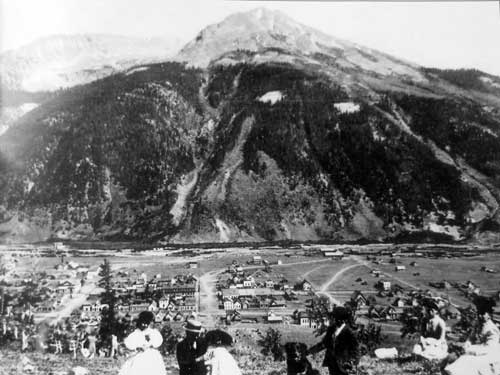
Silverton was already a decade old in this 1885 photo. The town allegedly got its name from a comment made by a local miner... "We don't have much gold here but we have silver by the ton."
Our first priority was to grab something to eat, so we randomly chose the highly-colorful Natalia's 1912 Restaurant which was right across the way.

Natalia's is the oldest still-standing bordello in Silverton. Built by John Curry (owner of the La Plata Newspaper) in 1883 during the height of the mining rush, John sold the building in 1887 to Nell Castell, one of the original madams on Blair Street. In spite of her success and notoriety, she sold it in 1894 to Austrian immigrant who had moved here to seek his mining fortune. He in turn sold it to his brother, who turned it into a saloon in 1909.
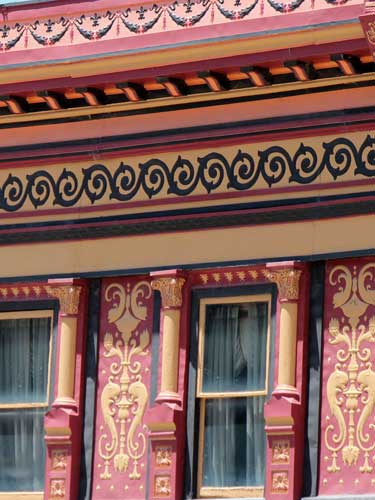
The colorful Nell Castell house

But who is Natalia??




Tin ceilings became popular in the States as an affordable alternative to the plasterwork found in wealthy European homes. The thin, durable, fireproof, light-weight tin or copper panels could mass produced... stamped with elegant designs, painted and easily be shipped anywhere. They reached the height of their popularity with the Victorian buildings of the 1890's. They had mostly lost their popularity by the 1930's.

Elk are very common in this area.

We then wandered up and down Empire/Blair Street.

Our first stop was the touristy Old Town Square, filled with a variety of gift shops.

They even had a spot where you could pan for your own gold or silver.

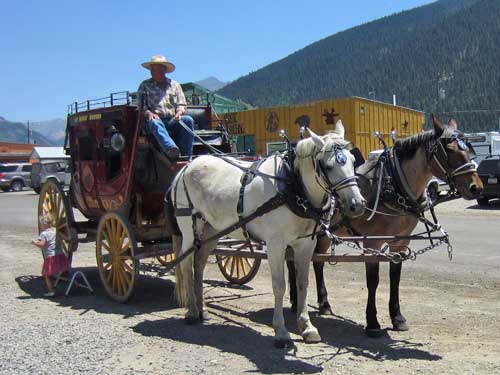
Sonny & Cher wait patiently for their next stage coach guests.

Built in 1888, this was the last brothel in Silverton. Run by Madam Jew Fanny, it eventually closed in 1947 because the 'ladies' were getting too much competition from the local girls who were 'giving it away for free' during all the patriotic fever during WWII.
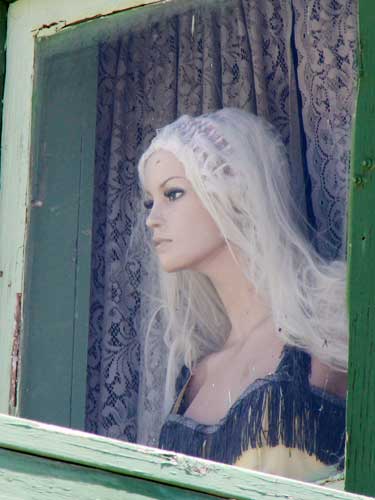
In spite of the fact that many of them lost their lives while helping care for sick children during an epidemic in the late 1800's, the ladies were not treated very well at all by the town. For example, they were not even allowed to be on the street except after 5 pm to go to the post office.


A couple of real-life shady ladies!

A pack of atv's motors though town.
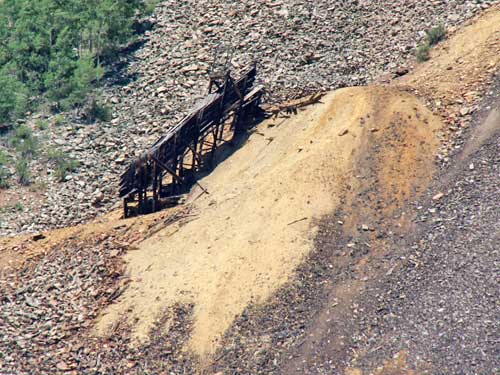
Covering the distant hillside is still evidence of old mines.


Also located up on the hill is the Christ of the Mines shrine. It's meant to show gratefulness for an event that happened in 1978. The 1970’s and early 80’s saw a resurgence of gold mining in the area. At the Lake Emma mine, miners had bored through the mountain horizontally (far below the lake) and then started digging upward. The gold was so bountiful, however, that miners continued to dig in spite of the fact that they were quickly approaching the bottom of the lake. On June 4, water broke through the mine and drained the entire lake, flooding the valley. Fortunately, this occurred on a Sunday... the one day of the week when nobody was in the mine.


Looking down Blair Street
Blair Street is named after Thomas Blair, one of the original San Juan prospectors who helped established the Silverton area. During its heyday, it was home to 32 saloons, gambling halls and houses of ill-repute... all within a three-block stretch.
The term Red Light District came from the red lanterns the railroad workers would carry with them so they could be easily found in case of an emergency. It just so happened that many of them hung outside the brothels during their off-shift hours.
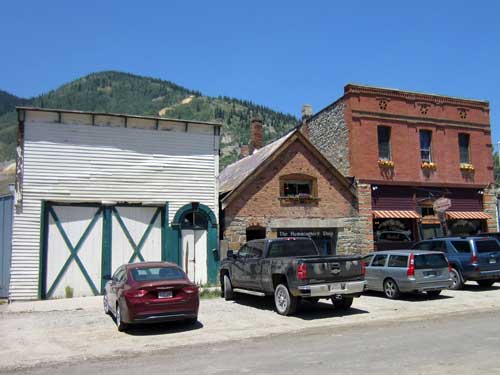
The center building was built in 1896.
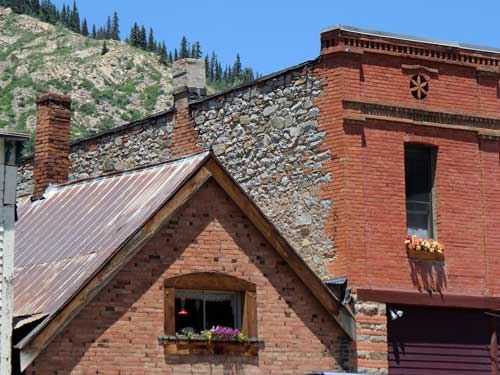

The original town jail (the smaller building on the left) was built in 1883.

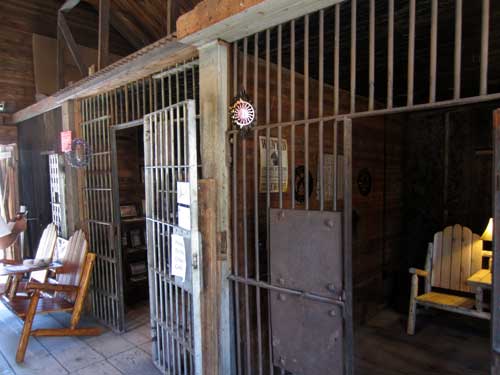
Inside were several art exhibits, including numerous Adirondack chairs.

I doubt the original inmates had such fancy seating!

Returning back up Blair Street
Eventually our time was up so we returned to our 12th street departure location. The train crews were busy arranging the trains so that the engines now led the way downhill.
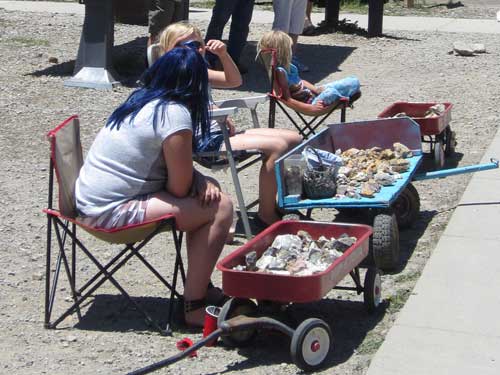
Some young entrepreneurs sell their local rocks and findings.

Arranging the trains


We sat in our same seats on the way back down, which put our view toward the other side of the tracks than we had coming up. The train didn't have to stop as much to take on water since it required a lot less steam going down the mountain.

Engine No. 481 takes us back down.

Heading toward the old depot

It was originally built as just a temporary structure in 1882.

Views of the town and surrounding peaks




An old mine


Large waterfalls flowed from the mountainside.
return • continue

